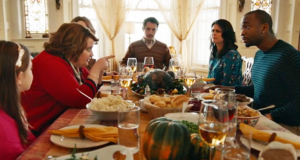As a great sage (a scriptwriter for Saturday Night Live) once wrote,
Thanksgiving with the family can be hard. Everyone has different opinions and beliefs.
The aftermath of people expressing their different opinions and beliefs at a family meal is beautifully parodied in the sketch, A Thanksgiving Miracle.
In Politeness Theory, personal offence is understood as resulting from a ‘face-threatening act’ that wasn’t appropriately attenuated. The notion of ‘face’ has been criticised for depending unquestioningly upon a ‘Western’ notion of the individual: each individual person has a ‘face’ that can be threatened. Everyday interaction requires that people commit face-threatening acts; the trick is to attenuate them using politeness strategies. (Though no one seems to have told Aunt Cathy that.)
My own work on face appears in a book edited by the Linguistic Politeness Research Group. It explores the idea of face not as ‘belonging’ to an individual, but instead as a ‘boundary formed around different levels of social structure, with the individual as one (and only one) of these structures’ (Clark 2011, p 111). It would be more in line with my current thinking to say face is the manifestation of social structure itself. According to this line of thought, the conflict between Aunt Cathy and her nice is not so much two individual people with two different people expressing their ‘opinions’. It’s more that Aunt Cathy and her niece each locate their existence within a particular social structure. The conflict is not between two individuals, but two different social worlds.
I illustrate this notion by exploring a bit of conversation in which Ally, an 18-year-old uni student from the South of England, describes feeling offended when she discovers that the women in her hall of residence enjoy drinking beer by the pint.
Emmanual Levinas has a different idea about face. His idea is that if I encounter another person, and I do not merely reduce that person to my own, totalising version of the social world, then I am ‘faced’ with some other form of being that I can not understand. Levinas recommends embracing that not-understanding as a way of accessing the infinite – that is, the world beyond my finite understanding.
If we were to apply Levinas’s ideas about face to my idea that face is the manifestation of social structure, than when two social structures meet each other – face-to-face – the potential arises for social transformation. The encounter gives us access to a social world that has not yet been imagined.
And if we’re not quite ready for that as-yet-unimagined social structure, well, we can always find solace in Adele. Thanks, Adele!


One thought on “Episode 20: Facing Thanksgiving”